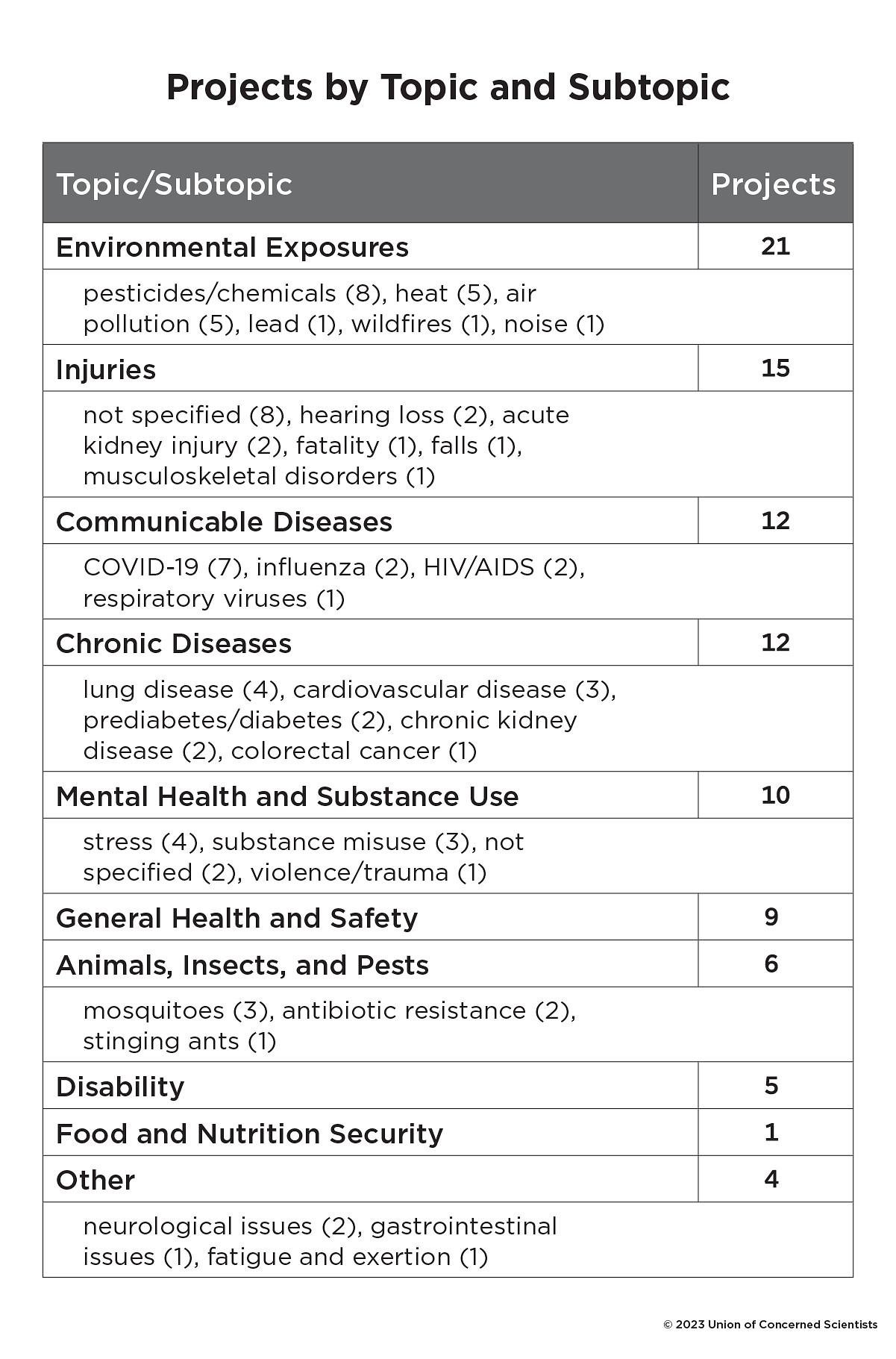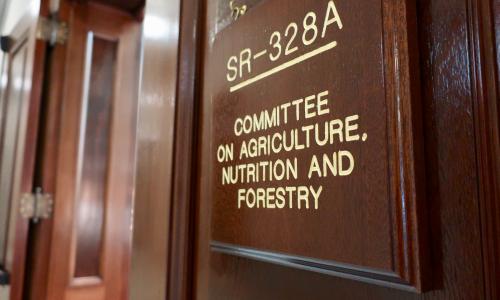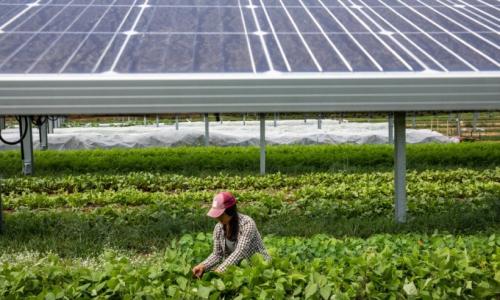Federal agencies are underfunding research on farmworker health, including areas that urgently need attention.
The millions of US farmworkers who produce our food face a multitude of health hazards. Yet US law and employers afford them only limited protections.
This analysis highlights the need for robust research from federal agencies. We recommend that the USDA increases funding for research on farmworker health in the next food and farm bill. Further, federal funding should encourage cross-agency collaboration, prioritize research on the combined impacts of climate change and multiple pesticide exposures, and create opportunities to serve populations underrepresented in current research.
Investing in Farmworker Health
This is the executive summary of the report. For all figures, references, and the full text, please download the PDF.
The estimated 2.4 million farmworkers working on US farms and ranches encounter a variety of hazards—from dangerous equipment, exposure to toxic pesticides and extreme heat, and more (NASS 2019; Goldman et al. 2021). US law and agricultural employers afford only limited protections to these workers, many of whom are immigrants and people of color experiencing systemic racism in the industry and broader society. Systems of economic exploitation and discrimination have functioned to institutionalize poor working environments and high rates of injury and illness in agriculture, an industry that relies heavily on the labor of immigrant populations and people of color. Low wages, substandard housing, insufficient access to health care, and weak legal protections stemming from immigration status are among the conditions that affect worker well-being, including their mental health and nutrition security (Goldman et al. 2021; Elver 2018).
Policymakers have access to substantial evidence of the industry's occupational hazards—including from farmworkers' firsthand experiences—yet important data gaps persist. The need for robust research and action has only grown more urgent in recent years as threats from extreme heat and other impacts related to climate change have escalated and the COVID-19 pandemic added to the risks for agricultural workers (Ferguson, Dahl, and DeLonge 2019; Lusk and Chandra 2021). Policymakers, farm owners, and health care providers must act urgently on available information, while also seeking better information on how to reduce workplace risks and protect worker health.
The federal government has an important role to play in advancing research and interventions to protect farmworkers. While performing the labor that underpins the food and agriculture industry that contributed, on average, $1.223 trillion to the US economy between fiscal years 2019 and 2022, farmworkers are exposed to health and safety risks from toxic pesticides, extreme heat, and dangerous work environments (BEA, n.d.). But federal agencies focusing on agriculture and health, including the National Institute of Food and Agriculture (NIFA), the National Institutes of Health (NIH), and the Centers for Disease Control and Prevention (CDC), are investing just $16.2 million a year in research and education on farmworker health, roughly $6.75 per worker, according to new analysis by the Union of Concerned Scientists (UCS).
Out of a total of 55 projects funded during the four-year span, NIFA funded 32, the NIH funded 15, and the CDC 7; the Department of Veterans Affairs funded a single project. Among the topics addressed, 21 projects focused on environmental exposures, 15 focused on injuries, 12 on communicable diseases, and 12 on chronic diseases. Ten projects focused on mental health and substance use; animals, insects, and pests were the focus in six; and disability in five. One project focused on food insecurity (Table 1).

With respect to target populations, five projects included youth farmworkers and five focused on farmworkers with disabilities. Three projects explicitly listed veteran farmworkers. None named women, LGBTQ+, gender nonconforming, or nonbinary farmworkers as populations of interest. Only 13 projects specified farmworkers as the only target population.
Our analysis, which attempts to capture the largest likely sources of federal funding for farmworker health research (not every source), points to significant opportunities to improve the breadth and depth of research, education, and extension programs supporting farmworker health. These opportunities include increasing funding for research on farmworker health at NIFA through the 2023 food and farm bill. Additional funding for research could come from the NIH and CDC. Further support is needed to prioritize research on the combined impacts of climate change and multiple pesticide exposures and to create opportunities to serve populations underrepresented in current farmworker health research, including Indigenous populations, women, aging farmers, and LGBTQ+, gender nonconforming, and nonbinary farmworkers. Also, the federal government should provide transparent, consistent, and frequently updated data on federal funding.
Finally, it is crucial to facilitate partnerships between research institutions and farmworker communities to ensure that farmworkers are central to research that affects them. It was difficult from the limited information about current grants to assess whether and how grantees engaged with farmworkers or farmworker organizations.
In addition to these research needs, protecting farmworkers requires policy changes, including improving federal regulation of pesticides and other chemicals used in agriculture; providing better labor protections; mandating the effective regulation of industries producing, distributing, and using agrochemicals; and enacting immigration policies to guarantee the rights and protections to which farmworkers are entitled, regardless of their immigration status. This is the appropriate action given the importance of the labor they contribute as well as the need to transition from exploitative practices in agriculture. A parallel track should be the work to provide a path to citizenship for those laborers who desire it. Also essential are better enforcement of occupational health and safety standards, including field sanitation, the inclusion of agricultural workers in wage laws, and expanded access to health care and benefits (Donley 2019; APHA 2017; Farmworker Justice, n.d.).
Taken together, these funding and policy changes could lead to significant progress in protecting the health of the people who produce our food and ensuring the health and long-term sustainability of the US food system.
This is the executive summary of the report. For all figures, references, and the full text, please download the PDF.
Downloads
Citation
Union of Concerned Scientists. 2023. Investing in Farmworker Health: How Research Can Help Protect the People Who Produce Our Food. Cambridge, MA. https://doi.org/10.47923/2023.15063



